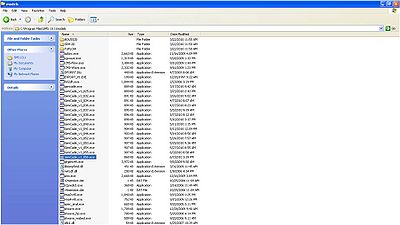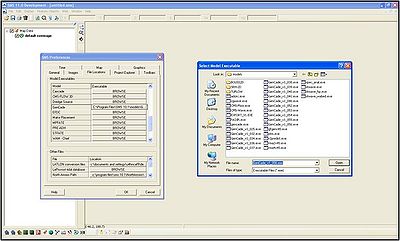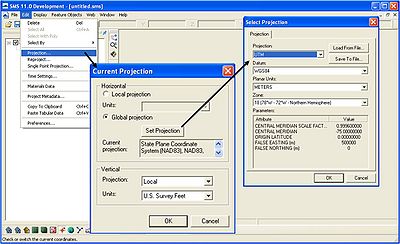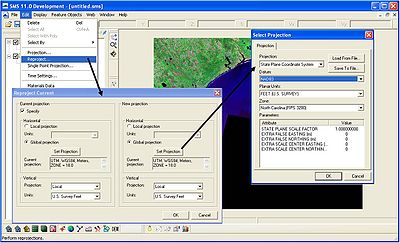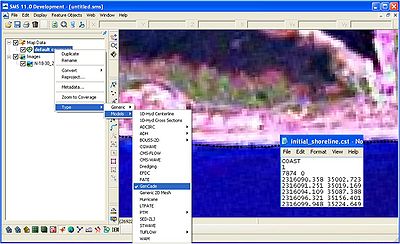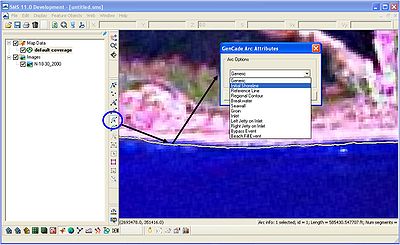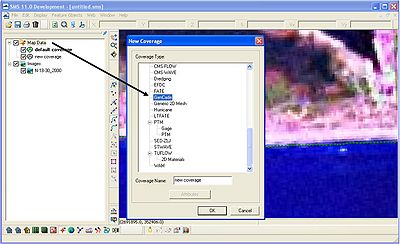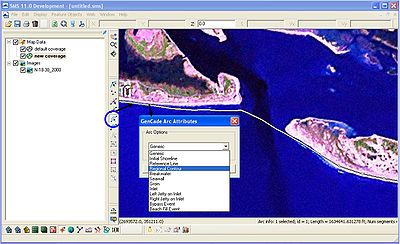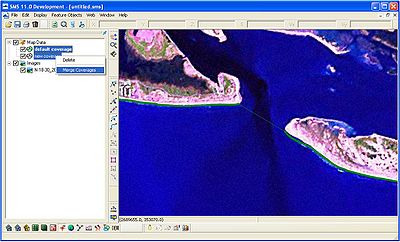GenCade: Difference between revisions
| Line 68: | Line 68: | ||
After the initial shoreline and regional contour have been loaded and defined in the SMS interface, it is necessary to merge the two lines in a single coverage. All structures, inlets, wave gages, and other features will be created in this single coverage. Highlight both the default coverage (initial shoreline) and the new coverage (regional contour). Right-click and select Merge Coverages (Figure 9). A window will open asking "Do you want to delete the coverages used to make the merged coverage?" By selecting no, the initial shoreline and regional contour will remain in the interface and if a problem occurs, these coverages can be merged again. It may be necessary to redefine the shoreline and regional contour in this new coverage. | After the initial shoreline and regional contour have been loaded and defined in the SMS interface, it is necessary to merge the two lines in a single coverage. All structures, inlets, wave gages, and other features will be created in this single coverage. Highlight both the default coverage (initial shoreline) and the new coverage (regional contour). Right-click and select Merge Coverages (Figure 9). A window will open asking "Do you want to delete the coverages used to make the merged coverage?" By selecting no, the initial shoreline and regional contour will remain in the interface and if a problem occurs, these coverages can be merged again. It may be necessary to redefine the shoreline and regional contour in this new coverage. | ||
[[Image: | [[Image:merge coverages.jpg|400px|thumb|left|Figure 9. Merge coverages]] | ||
<br style="clear:both" /> | <br style="clear:both" /> | ||
Revision as of 20:23, 23 September 2010
GenCade
POCs: Ashley Frey <br\>Ashley.E.Frey@usace.army.mil <br\>601-634-2006 <br\>US Army Engineer Research and Development Center (ERDC) <br\>Coastal and Hydraulics Lab (CHL)
<br\>Nick Kraus <br\>Nicholas.C.Kraus@usace.army.mil <br\>601-634-2016 <br\>US Army Engineer Research and Development Center (ERDC) <br\>Coastal and Hydraulics Lab (CHL)
GenCade is a 1D model that combines GENESIS with Cascade. It is operated within the Surface-water Modeling System (SMS) interface. The first open release of GenCade is expected to occur in December 2010. A user guide, examples of simple cases, and applications will be posted here.
User Guide
Getting Started
This guide of GenCade was developed in September 2010. Most of the screenshots used in this guide were created with the July 29, 2010, build of the SMS. The August 25, 2010, build was used to create the screenshots for the Developing Alternatives and Time-dependent Wave Transmission sections. This guide refers to GenCade_v1_066.exe as the most recent executable. Developers are constantly upgrading the SMS and GenCade executables, so a future version may look slightly different from this user guide.
Setup GenCade in the SMS
GenCade is one model available in the SMS (Surface-water Modeling System) interface. To use GenCade, a working version of SMS 10.1 and executable for SMS 11.0 Development are necessary. The SMS 11.0 Development executable is copyrighted, so a registration code is necessary before using.
First, locate the GenCade executable on your machine. Drop the executable into the models folder under SMS 10.1 as shown in Figure 1.
Once again, the capabilities of GenCade are only available in SMS 11.0 Development. If SMS 10.1 is already installed on the computer and a registration code for SMS 11.0 Development has been obtained, simply drag the SMS 11.0 executable into the SMS 10.1 folder (most likely in Program Files). Double-click on the SMS 11.0 executable to open SMS 11.0 Development. At this time, a prompt will open asking for the registration code. Before beginning to work in GenCade, go to Edit->Preferences. Select the tab File Locations and scroll down to GenCade under Model Executables. Click the button under Executable located directly to the right of GenCade. If GenCade has not been used previously, the button will most likely say BROWSE. After selecting this button, find the latest GenCade executable on the computer and select. The row to the right will specify the location of the executable which will be used to run GenCade (Figure 2).
Set the current projection
GenCade uses a real world coordinate system, so it is necessary to set up the current projection upon opening the SMS. Aerial photos, shorelines, and other georeferenced files can be opened in the SMS. Go to Edit->Projection and define the current projection (Figure 3). This will ensure all shorelines, structures, wave gages, and other important features are mapped correctly.
Reproject current projection
In some cases, the shorelines and the aerial photo may be in different coordinate systems. To change the projection, go to Edit->Reproject. A new window will open where the current projection and new projection can be specified (Figure 4).
Preparing Input Files
Initial shoreline
Before dragging a file into the SMS interface, right click on default coverage under Map Data in the left panel. Select Type->Models->GenCade. To bring in a shoreline or regional contour as a *.cst, the original text file must be modified. See Figure 5 for the required format. The first number in the third row represents the number of points in the file. The other numbers in the first three rows will remain the same.
Once the shoreline is represented in the interface, click the Select Feature Arc button and double-click on the shoreline. The GenCade Arc Attributes will open. Select Initial Shoreline and click OK (Figure 6). Now the shoreline is defined.
Regional contour or additional shorelines
In some cases, it may be necessary to include a regional contour or additional shorelines. Right-click on Map Data and select New Coverage. A window will open; scroll down and select GenCade as the coverage type (Figure 7). Open the regional contour in the interface, and click on the Select Feature Arc button. After double-clicking on the regional contour, select Regional Contour as the Arc Option in the GenCade Arc Attributes window (Figure 8). Additional shorelines can be added in a similar fashion.
Merge coverages
After the initial shoreline and regional contour have been loaded and defined in the SMS interface, it is necessary to merge the two lines in a single coverage. All structures, inlets, wave gages, and other features will be created in this single coverage. Highlight both the default coverage (initial shoreline) and the new coverage (regional contour). Right-click and select Merge Coverages (Figure 9). A window will open asking "Do you want to delete the coverages used to make the merged coverage?" By selecting no, the initial shoreline and regional contour will remain in the interface and if a problem occurs, these coverages can be merged again. It may be necessary to redefine the shoreline and regional contour in this new coverage.
